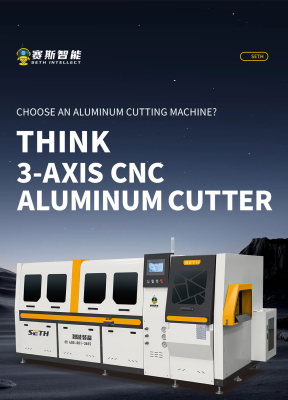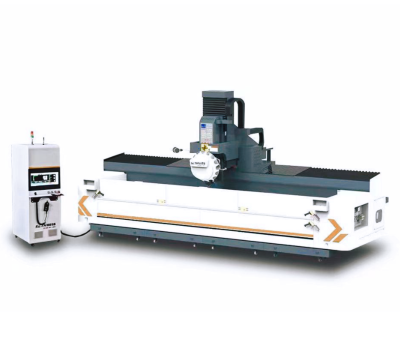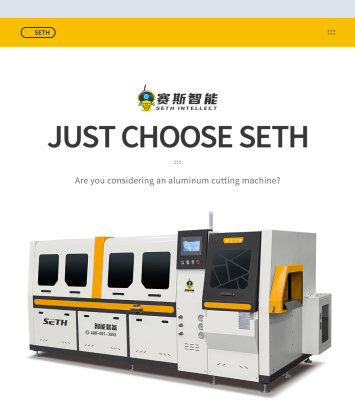Window Machine Aluminum profile CNC Double Head Mitre Saw With 600mm Saw blade
Exceptional Machining Precision for High-Quality Joints
Dual-Head Synchronous Operation for Enhanced Efficiency
3. Strong Adaptability to Diverse Processing Needs
4. Intelligent Operation and Comprehensive Safety Protection
5. Stable Performance and Long Service Life
1. Product Overview :
The 5-axis compound angle double-head cutting saw is a specialized CNC equipment designed for high-precision cutting of aluminum profiles, especially for processing complex compound angles (e.g., 45°/90°/135°) required in door/window frames, curtain wall structures, and industrial aluminum assemblies.
Unlike traditional single-head or 3-axis cutting machines, it integrates 5-axis linkage technology and dual-head synchronous operation, enabling one-time forming of multi-angle joints and significantly improving the efficiency and accuracy of aluminum profile cutting. It is widely used in high-end construction, furniture manufacturing, and transportation industries, where strict requirements for profile assembly precision (e.g., seam gap ≤0.1mm) and cutting efficiency are demanded.
2. Core Advantages (1) 5-Axis Linkage for Complex Angles Equipped with 5 interpolated axes (X, Y, Z, A, C), the saw can adjust the cutting angle of each saw head independently. The A-axis (rotation around X-axis) and C-axis (rotation around Z-axis) support compound angle cutting ranging from -45° to +135°, fully meeting the processing needs of special-shaped aluminum profiles such as "herringbone joints" and "oblique cross joints".
(2) Double-Head Synchronous Operation The two saw heads (left and right) can work simultaneously or independently. When processing long aluminum profiles (up to 6000mm), the double heads can cut both ends at the same time, reducing the processing time by 50% compared with single-head machines. Additionally, the saw heads are equipped with independent servo drives, ensuring consistent cutting speed and angle accuracy between the two heads.
(3) High Cutting Precision & Quality Adopts imported high-speed steel saw blades (diameter 400-500mm) with tungsten carbide tips, ensuring smooth cutting surfaces without burrs; The machine bed is made of high-strength cast iron and undergoes aging treatment to eliminate internal stress, minimizing deformation during high-speed cutting; Equipped with a precision linear guide rail system and ball screws, the positioning accuracy of the saw head reaches ±0.02mm, and the repeat positioning accuracy is ±0.01mm.
(4) Intelligent Operation & Safety Protection Features a 10-inch touchscreen CNC system, supporting CAD/CAM file import (e.g., DXF format) and preset cutting parameter libraries for quick setup; Integrates multiple safety devices, including emergency stop buttons, protective covers with interlocks, and overload protection for the saw motor, ensuring operator safety during operation; Equipped with an automatic chip collection system, which sucks and collects aluminum chips in real-time to keep the working environment clean.
3. Key Technical Specifications
4. Working Process Profile Loading & Clamping:
Place the aluminum profile on the feeding table, and the pneumatic clamping device (with adjustable pressure) automatically fixes the profile to prevent displacement during cutting; Parameter Setting: Import the cutting drawing via the CNC system or select a preset processing program, set the cutting length, angle (A/C axis values), and saw blade speed; Saw Head Positioning: The servo motor drives the X/Y/Z axes to move the left and right saw heads to the preset cutting positions, and the A/C axes adjust the saw blades to the required compound angles; Synchronous Cutting: The two saw heads start cutting simultaneously (or sequentially according to the program), with the cooling system spraying coolant to reduce saw blade wear and ensure cutting quality; Unloading & Chip Cleaning: After cutting, the saw heads return to the origin, the clamping device releases, and the finished profile is unloaded. The chip collection system cleans the cutting area automatically.
5. Application Scenarios High-end aluminum alloy doors and windows: Cutting of frame profiles with 45° compound angle joints; Curtain wall engineering: Processing of aluminum profiles for glass curtain wall supports and connectors; Industrial aluminum frames: Cutting of aluminum profiles for mechanical equipment frames and display racks; Transportation industry: Processing of aluminum profiles for train/bus interior decorative parts and luggage racks.
I. High-end Aluminum Alloy Doors and Windows In the production of premium aluminum alloy doors and windows, the equipment primarily serves to cut composite corner joints for frame profiles, which is crucial for ensuring both sealing performance and aesthetic precision. For instance, the connection between frames and sashes in insulated aluminum windows requires a 45° composite corner joint. Traditional cutting equipment often produces gaps exceeding 0.1mm due to angular deviations, leading to air leakage and water infiltration. The 5-axis equipment, with its ±0.01mm repeat positioning accuracy, can precisely cut joints with angular errors ≤0.02°. Combined with dual-head synchronized operation, it completes cutting at both ends of the window frame simultaneously, reducing processing time from 15 minutes on conventional equipment to under 8 minutes for single-sash frames. Additionally, for irregular-shaped profiles in curved windows, the equipment can create variable-angle joints compatible with curved structures through coordinated operation of the A-axis (-45° to +45°) and C-axis (0° to 135°), meeting customization demands for villas and high-end apartments. II. Curtain Wall Engineering In glass curtain walls and stone curtain walls, the equipment mainly processes structural support frames and connecting components. Curtain wall structures require extremely high dimensional accuracy and angular consistency of aluminum profiles. For example, the connection between curtain wall columns and beams demands a 90° right-angle cut with surface flatness controlled within 0.05mm. Any deviation may cause bolt misalignment during installation, compromising the curtain wall's load-bearing performance. The equipment utilizes high-precision linear guides and imported saw blades, achieving a cutting surface roughness of Ra1.6μm that eliminates the need for subsequent grinding during assembly. For ultra-long curtain wall profiles (e.g., 6-8m column profiles), it offers a customizable maximum cutting length of 8000mm with dual-head synchronous cutting technology. This innovation resolves the "end-to-end error accumulation" issue common in traditional single-head equipment processing long profiles, ensuring angular deviations at both ends of 6m profiles remain ≤0.03mm, fully compliant with GB/T 21086-2007 curtain wall engineering standards. III. Industrial Aluminum Frame Applications In manufacturing industrial aluminum frames for machinery, automated production lines, and display racks, the equipment efficiently processes multi-specification and multi-angle frame profiles. For example, aluminum machine frames in automated production lines often require simultaneous processing of connection ports at 30°,45°, and 90° angles. Traditional equipment necessitates multiple fixture adjustments, resulting in low efficiency and error risks. The 5-axis equipment achieves "one-click configuration change" through preset parameter libraries, enabling rapid switching between different angles without re-adjusting fixtures. For thick-walled aluminum profiles (wall thickness 8-15mm) in mechanical frames, the equipment features a 3.7kW×2 dual main motor and 450mm tungsten steel saw blades, achieving a cutting feed speed of 500mm/min. This represents a 30% efficiency improvement over traditional equipment, with cutting edges free from burrs that require no secondary processing for direct welding or bolted connections, significantly reducing industrial frame production cycles. IV. Transportation Sector In the manufacturing of interior and structural components for rail transit (high-speed rail, subway) and commercial vehicles (passenger cars, trucks), the equipment primarily processes lightweight aluminum profiles. For instance, luggage racks and interior wall panel supports in high-speed rail carriages require cutting irregular composite angles (such as 135° bevels + 45° chamfers), with the profiles needing high surface flatness to maintain aesthetic assembly quality. The equipment's C-axis enables wide-angle adjustment from 0° to 135°, combined with precise Z-axis feed, allowing single-pass cutting of complex irregular angles. Additionally, the integrated automatic chip collection system prevents aluminum chips from adhering to the profiles, ensuring surface quality compliance with transportation industry standards (surface scratch depth ≤0.05mm). Furthermore, for long aluminum profiles in passenger car bodies (e.g., 5-7m side panels), the dual-head synchronous cutting function enables continuous operation through "one-end cutting, one-end clamping," achieving 1.5 times the daily processing capacity of traditional equipment to meet mass production demands in the transportation industry.
Related Products
Submitted successfully
We will contact you as soon as possible




